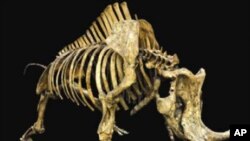The Los Angeles Natural History Museum has unveiled an exhibit that shows the story of mammals over the past 65 million years. The display is housed in a restored historic building, and it traces the story of life on earth since the extinction of the dinosaurs.
The exhibit, called Age of Mammals, shows what happened when small mammals no longer had to compete with the giant reptiles, after the mass extinction of dinosaurs caused by a climate shift. The sudden change was probably the result of a comet hitting the earth or a large volcanic eruption.
Museum vice president Karen Wise says the story of mammals is still unfolding today, partly through the work of scientists at the museum.
"And you can see these extinct mammals and these extinct mammoths and mastodons and giant sloths and strange creatures like the bronto there, that you look at that thing and you say, what in the world is that? It kind of looks like a rhinoceros, but not really. What is that thing? And saber-tooth cats and all of these strange forms that have evolved and then died out over the last 65 million years. And then of course, our own story, the evolution of humans," he said.
Visitors see how life has changed, for example, through the fossilized skeleton of a tiny horse, the size of a dog, from 50 million years ago. Some specimens are local, including the skull of a rhinoceros from coastal California from 30 million years ago, and a mysterious 10-million-year-old amphibious animal that is related to the elephant and the sea cow. The skeleton of a 50,000-year-old mastodon comes from Simi Valley, which is today a quiet Los Angeles suburb.
Wise notes the museum's scientists uncovered some of the artifacts from the nearby La Brea Tar Pits and other local sites. Some are from recent excavations and some have been here for decades.
"We have always had these collections, and we have always had them on display, but we never really featured them. And we are making it easy to say, this is a Simi Valley mastodon, this is from the La Brea tar pits, this is from Ventura County. This is from Red Rock Canyon, which is a state park right outside Los Angeles. You can see the locations today where these fossils came from, and you can actually see the research going on today," he said.
The new exhibit is housed in the historic core of the museum complex, the original building constructed between 1910 and 1913. It has been upgraded to withstand earthquakes and refurbished on the outside. Inside, says architect Jorge de la Cal, the exhibit is brightly lit and modern, although it is the oldest part of museum. "We wanted to use materials that did not look historic - glass, steel, aluminum, things that were clearly not to be confused with 1913 - and also that were transparent, that brought light in, and that glittered in a way that made it feel fresh and airy," he said.
Historic paintings by famed museum artist Charles R. Knight adorn the second floor beneath a restored rotunda. Wise says Knight worked with scientists to portray Ice Age animals as accurately as was possible at the time, in the first half of the 20th century. She says a series of his paintings shows the evolution of life from protozoa to humans.
"And each one has a comment by a contemporary curator from the natural history museum explaining what was depicted in the past, and what we have learned since then. So it is a lot of fun," she said.
Chief curator John Harris oversees the ongoing excavation of Ice Age animals at the La Brea Tar Pits. He says the exhibit shows museum visitors that the past has a message for the present.
"Continents move, climates change, mammals evolve, and we hope they go home with the realization that the biodiversity of today represents billions of years of evolution, but we are now in the position where we are influencing climate and life on earth, and so it is our responsibility to save the biodiversity that we see today for posterity," he said.
The newly reopened section of the museum will house additional exhibitions when the restoration project has been finished. One, to open next year, will look at dinosaur mysteries, and two later exhibits will look at the natural and cultural history of Los Angeles. Consisting of indoor and outdoor displays, they will be open in time for the museum's centennial celebration in 2013.










